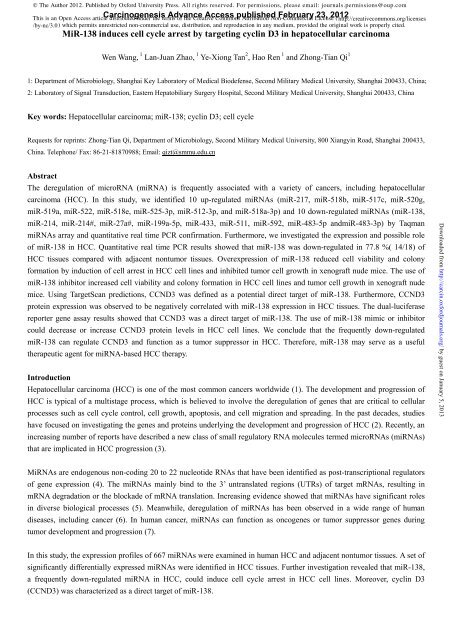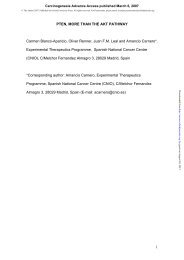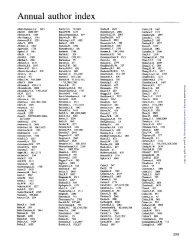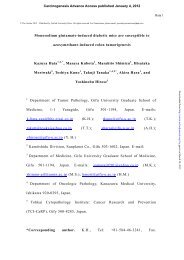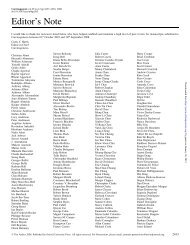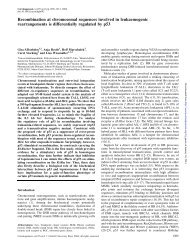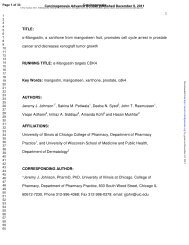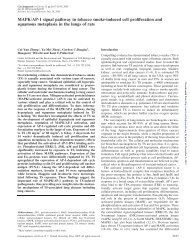MiR-138 induces cell cycle arrest by targeting ... - Carcinogenesis
MiR-138 induces cell cycle arrest by targeting ... - Carcinogenesis
MiR-138 induces cell cycle arrest by targeting ... - Carcinogenesis
You also want an ePaper? Increase the reach of your titles
YUMPU automatically turns print PDFs into web optimized ePapers that Google loves.
Ó The Author 2012. Published <strong>by</strong> Oxford University Press. All rights reserved. For permissions, please email: journals.permissions@oup.com<br />
<strong>Carcinogenesis</strong> Advance Access published February 23, 2012<br />
This is an Open Access article distributed under the terms of the Creative Commons Attribution Non-Commercial License ( http://creativecommons.org/licenses<br />
/<strong>by</strong>-nc/3.0)<br />
which permits unrestricted non-commercial use, distribution, and reproduction in any medium, provided the original work is properly cited.<br />
<strong>MiR</strong>-<strong>138</strong> <strong>induces</strong> <strong>cell</strong> <strong>cycle</strong> <strong>arrest</strong> <strong>by</strong> <strong>targeting</strong> cyclin D3 in hepato<strong>cell</strong>ular carcinoma<br />
Wen Wang, 1 Lan-Juan Zhao, 1 Ye-Xiong Tan 2 , Hao Ren 1 and Zhong-Tian Qi 1<br />
1: Department of Microbiology, Shanghai Key Laboratory of Medical Biodefense, Second Military Medical University, Shanghai 200433, China;<br />
2: Laboratory of Signal Transduction, Eastern Hepatobiliary Surgery Hospital, Second Military Medical University, Shanghai 200433, China<br />
Key words: Hepato<strong>cell</strong>ular carcinoma; miR-<strong>138</strong>; cyclin D3; <strong>cell</strong> <strong>cycle</strong><br />
Requests for reprints: Zhong-Tian Qi, Department of Microbiology, Second Military Medical University, 800 Xiangyin Road, Shanghai 200433,<br />
China. Telephone/ Fax: 86-21-81870988; Email: qizt@smmu.edu.cn<br />
Abstract<br />
The deregulation of microRNA (miRNA) is frequently associated with a variety of cancers, including hepato<strong>cell</strong>ular<br />
carcinoma (HCC). In this study, we identified 10 up-regulated miRNAs (miR-217, miR-518b, miR-517c, miR-520g,<br />
miR-519a, miR-522, miR-518e, miR-525-3p, miR-512-3p, and miR-518a-3p) and 10 down-regulated miRNAs (miR-<strong>138</strong>,<br />
miR-214, miR-214#, miR-27a#, miR-199a-5p, miR-433, miR-511, miR-592, miR-483-5p andmiR-483-3p) <strong>by</strong> Taqman<br />
miRNAs array and quantitative real time PCR confirmation. Furthermore, we investigated the expression and possible role<br />
of miR-<strong>138</strong> in HCC. Quantitative real time PCR results showed that miR-<strong>138</strong> was down-regulated in 77.8 %( 14/18) of<br />
HCC tissues compared with adjacent nontumor tissues. Overexpression of miR-<strong>138</strong> reduced <strong>cell</strong> viability and colony<br />
formation <strong>by</strong> induction of <strong>cell</strong> <strong>arrest</strong> in HCC <strong>cell</strong> lines and inhibited tumor <strong>cell</strong> growth in xenograft nude mice. The use of<br />
miR-<strong>138</strong> inhibitor increased <strong>cell</strong> viability and colony formation in HCC <strong>cell</strong> lines and tumor <strong>cell</strong> growth in xenograft nude<br />
mice. Using TargetScan predictions, CCND3 was defined as a potential direct target of miR-<strong>138</strong>. Furthermore, CCND3<br />
protein expression was observed to be negatively correlated with miR-<strong>138</strong> expression in HCC tissues. The dual-luciferase<br />
reporter gene assay results showed that CCND3 was a direct target of miR-<strong>138</strong>. The use of miR-<strong>138</strong> mimic or inhibitor<br />
could decrease or increase CCND3 protein levels in HCC <strong>cell</strong> lines. We conclude that the frequently down-regulated<br />
miR-<strong>138</strong> can regulate CCND3 and function as a tumor suppressor in HCC. Therefore, miR-<strong>138</strong> may serve as a useful<br />
therapeutic agent for miRNA-based HCC therapy.<br />
Introduction<br />
Hepato<strong>cell</strong>ular carcinoma (HCC) is one of the most common cancers worldwide (1). The development and progression of<br />
HCC is typical of a multistage process, which is believed to involve the deregulation of genes that are critical to <strong>cell</strong>ular<br />
processes such as <strong>cell</strong> <strong>cycle</strong> control, <strong>cell</strong> growth, apoptosis, and <strong>cell</strong> migration and spreading. In the past decades, studies<br />
have focused on investigating the genes and proteins underlying the development and progression of HCC (2). Recently, an<br />
increasing number of reports have described a new class of small regulatory RNA molecules termed microRNAs (miRNAs)<br />
that are implicated in HCC progression (3).<br />
<strong>MiR</strong>NAs are endogenous non-coding 20 to 22 nucleotide RNAs that have been identified as post-transcriptional regulators<br />
of gene expression (4). The miRNAs mainly bind to the 3’ untranslated regions (UTRs) of target mRNAs, resulting in<br />
mRNA degradation or the blockade of mRNA translation. Increasing evidence showed that miRNAs have significant roles<br />
in diverse biological processes (5). Meanwhile, deregulation of miRNAs has been observed in a wide range of human<br />
diseases, including cancer (6). In human cancer, miRNAs can function as oncogenes or tumor suppressor genes during<br />
tumor development and progression (7).<br />
In this study, the expression profiles of 667 miRNAs were examined in human HCC and adjacent nontumor tissues. A set of<br />
significantly differentially expressed miRNAs were identified in HCC tissues. Further investigation revealed that miR-<strong>138</strong>,<br />
a frequently down-regulated miRNA in HCC, could induce <strong>cell</strong> <strong>cycle</strong> <strong>arrest</strong> in HCC <strong>cell</strong> lines. Moreover, cyclin D3<br />
(CCND3) was characterized as a direct target of miR-<strong>138</strong>.<br />
Downloaded from<br />
http://carcin.oxfordjournals.org/ <strong>by</strong> guest on January 5, 2013
Materials and methods<br />
Tissue specimens and <strong>cell</strong> lines<br />
Eighteen pairs of human HCC and adjacent nontumor tissues were obtained from surgical specimens immediately after<br />
resection from patients undergoing primary surgical treatment of HCC in the Eastern Hepatobiliary Surgery Hospital,<br />
Shanghai, China. No patient had received preoperative irradiation or chemotherapy. The samples were frozen in liquid<br />
nitrogen and stored at -80°C until use. Among these samples, three pairs were used for Taqman low density miRNA array<br />
(TLDA) analysis and all of them were used for quantitative real time PCR (qRT-PCR) analysis. Clinical and pathological<br />
information was extracted from the patients’ medical charts and pathology reports (Table 1). Written consent for tissue<br />
donation (for research purposes) was obtained from the patients before tissue collection and the protocol was approved <strong>by</strong><br />
the Institutional Review Board of Eastern Hepatobiliary Surgery Hospital and Second Military Medical University.<br />
Human embryonic kidney <strong>cell</strong>s (HEK293T) and human HCC <strong>cell</strong>s lines HepG2 and Huh7 were cultured in DMEM medium<br />
plus 10% FBS (Invitrogen, Carlsbad, CA, USA) at 37°C in a humidified atmosphere containing 5% CO2.<br />
Taqman low density miRNA array<br />
Total RNA was isolated using mirVana miRNA isolation kit (Ambion, Austin, TX, USA). For miRNA cDNA synthesis,<br />
RNA was reverse transcribed using the miRNA reverse transcription kit (Applied Biosystems, Foster City, CA, USA) in<br />
combination with the stem-loop Megaplex primer pool (Applied Biosystems). Then, low density miRNA Taqman array v2.0<br />
was performed as the manufacture’s protocol. For each cDNA sample, 667 small RNAs were profiled. All PCR reactions<br />
were performed on the 7900HT real time PCR system (Applied Biosystems). Cycling conditions were as follows: 95°C for<br />
10 min followed <strong>by</strong> 40 <strong>cycle</strong>s of 95°C for 15 sec and 60°C for 1 min. Human U6 small RNA was used as an internal control<br />
to normalize RNA input. The data were analyzed <strong>by</strong> SDS v2.3 software. In details, the Ct value is defined as the fractional<br />
<strong>cycle</strong> number at which the fluorescence passes the fixed threshold. The fold change was calculated using the 2 –ΔΔCt method<br />
and presented as the fold-expression change in tumors relative to their corresponding normal tissues after normalization to<br />
the endogenous control.<br />
Quantitative real time PCR<br />
Synthesis of cDNA and qRT-PCR analysis of miRNA expression was carried out with TaqMan microRNA assay kits<br />
(Applied Biosystems) according to the manufacturer’s protocol. Briefly, total RNA was extracted using TRIzol Reagent<br />
(Invitrogen) from clinical samples or HCC <strong>cell</strong> lines, and were used to synthesize cDNAs with gene-specific primers.<br />
Reverse transcriptase reactions contained 100ng RNA, 50 nmol/L stem-loop RT primers, 1×RT buffer, 0.25mmol/L each of<br />
the dNTPs, 3.33U/μL MultiScribe reverse transcriptase and 0.25U/μL RNase inhibitor. The 15μL reactions were incubated<br />
for 30 min at 16°C, 30 min at 42°C, 5 min at 85°C, and then held at 4°C. The cDNA product was used for the following<br />
qRT-PCR analysis directly. The 20μL PCR reaction included 1.33μL RT product, 1×TaqMan universal PCR master mix and<br />
1μL primers and probe mix of the TaqMan microRNA assay kit. Reactions were incubated in a 96-well optical plate at 95°C<br />
for 5 min, followed <strong>by</strong> 40 <strong>cycle</strong>s at 95°C for 15 sec and 60°C for 1 min. PCR reactions were run on a StepOne Plus real<br />
time PCR machine (Applied Biosystems) and the data were analyzed <strong>by</strong> SDS v2.3 software same as in TLDA.<br />
The construction of luciferase reporter plasmids<br />
The fragment of 3’-UTR of CCND3 (1054-2061nt, Genbank accession no. NM_001136017.2) containing the two putative<br />
miR-<strong>138</strong> binding sequences (1279-1285nt and 1346-1352nt) was amplified with the primers<br />
5’-CCCTGGAGAGGCCCTCTGGA-3’ (forward) and 5’-TTCCAAGAAGCCAAAGCCAG-3’ (reverse). The PCR product<br />
was cloned into Firefly luciferase reporter vector pGL3 (Promega Corporation, Madison, WI, USA), termed as<br />
pGL3-CCND3-3’UTR. The plasmid which carried the mutated sequence in the two complementary sites for the seed region<br />
of miR-<strong>138</strong> (Fig.2A) was generated based on pGL3-CCND3-3’UTR plasmid <strong>by</strong> MutanBEST Kit (Takara Bio Inc., Shiga,<br />
JP), termed as pGL3-CCND3-3’UTR-mut. Briefly, a forward miR-<strong>138</strong> mutagenic primer F1-GAT<br />
ACATAGTGGTCGATTCCTTTTGAACGCCCCCCCCCACCCC and a reverse miR-<strong>138</strong> mutagenic primer<br />
R1-CAATTCTGTCCCATCAGCCTGGCCCSCCCCCSGCTSGSGTTG, or a forward miR-<strong>138</strong> mutagenic primer<br />
2<br />
Downloaded from<br />
http://carcin.oxfordjournals.org/ <strong>by</strong> guest on January 5, 2013
F2-CTGCATCTGTGGTCGAGCGCCTTTCCCAACT CTAGCTGGGG and a reverse miR-<strong>138</strong> mutagenic primer<br />
R2-GGAGGAGGAGCTTGACTAGCCACCGAAATGCAGACATGG, were synthesized and utilized in PCR experiment as<br />
described <strong>by</strong> the manufacturer. Two point mutations along the miR-<strong>138</strong> seed binding sites were confirmed <strong>by</strong> sequencing<br />
analyses.<br />
Transfection<br />
The transfections were carried out using FuGene HD transfection reagent (Roche, Indianapolis, IN, USA) following the<br />
manufacturer’s protocol. In brief, 2×10 4 HepG2 and Huh7 <strong>cell</strong>s or 5×10 4 HEK293T <strong>cell</strong>s in 24-well plate were transfected<br />
with indicated plasmid DNA, miRNA duplex (GenePharma, Shanghai, China), siRNA (GenePharma) and collected 24~48<br />
hours after transfection for assay.<br />
Cell viability assay<br />
Twenty four hours after transfection, 1000 transfected HepG2 and Huh7 <strong>cell</strong>s were placed in a fresh 96-well plate in<br />
triplicate and maintained in DMEM containing 10% FBS for 5 days. Cells were tested for proliferation per 24 hours using<br />
Cell Titer-Blue <strong>cell</strong> viability assay (Promega Corporation, Madison, WI, USA) according to the manufacturer's instructions<br />
and the fluorescence value was recorded <strong>by</strong> multi-plate reader (Synergy 2, BioTek, Winooski, VT, USA).<br />
Cell <strong>cycle</strong> analysis<br />
Forty eight hours after transfection, 1×10 5 transfected HepG2 and Huh7<strong>cell</strong>s were harvested, washed once in phosphate<br />
buffer saline (PBS), and fixed in 70% ethanol at 4°C overnight. Staining for DNA content was performed with 50mg/ml<br />
propidium iodide and 1mg/ml RNase A at room temperature for 30 min. Populations in G0-G1, S, and G2-M phase were<br />
measured <strong>by</strong> Cell Lab Quanta SC flow cytometry (Beckman Coulter, Fullerton, CA, USA) and the data were analyzed <strong>by</strong><br />
FlowJo v7.6 Software.<br />
Colony formation assay<br />
Twenty four hours after transfection, 2000 transfected HepG2 and Huh7<strong>cell</strong>s were placed in a fresh 6-well plate in triplicate<br />
and maintained in DMEM containing 10% FBS for 2 weeks. Cell colonies were fixed with 20% methanol and stained with<br />
0.1% coomassie brilliant blue R250 at room temperature for 15 min. The colonies were counted <strong>by</strong> ELIspot Bioreader 5000<br />
(BIO-SYS, Karben, GE).<br />
Tumorigenicity assays in nude mice.<br />
Male BALB/c nude mice (5 to 6 wk of age) were obtained from Shanghai Experimental Animal Center (Shanghai, China).<br />
Animal handling and experimental procedures were approved <strong>by</strong> the Animal Experiments Ethics Committee of Second<br />
Military Medical University. For in vivo tumorigenicity assay, all pyrimidine nucleotides in the miR-<strong>138</strong> mimic, miR-<strong>138</strong><br />
inhibitor or NC duplex were substituted <strong>by</strong> their 2’-O-methyl analogues to improve RNA stability. <strong>MiR</strong>-<strong>138</strong>mimic or<br />
miR-<strong>138</strong> inhibitor transfected HepG2 <strong>cell</strong>s (1×10 5 ) were suspended in 100uL PBS and then injected s.c. into left side of the<br />
posterior flank of 6 BALB/c nude mice, respectively. NC transfected or nontransfected HepG2 <strong>cell</strong>s (1×10 5 ) were injected<br />
subcutaneously into right side of same 12 mice. Tumor growth was examined daily and the tumor volumes were calculated<br />
every week using the formula for hemi-ellipsoids: V =length (cm) ×width (cm) ×height (cm) ×0.5236. After 5 weeks, the<br />
mice were sacrificed and the tumors were dissected and photographed.<br />
Dual-luciferase reporter assay<br />
HEK293T <strong>cell</strong>s seeded in 24 well plate in triplicate were cotransfected with pGL3-CCND3-3’UTR or<br />
pGL3-CCND3-3’UTR-mut and miRNA-<strong>138</strong> mimic or nonrelative control RNA duplex (NC duplex, GenePharma) <strong>by</strong> using<br />
FuGene HD transfection reagent. The pRL-TK (Promega Corporation, Madison, WI, USA) was also transfected as a<br />
normalization control. Cells were collected 48 hrs after transfection, and luciferase activity was measured using a<br />
dual-luciferase reporter assay kit (Promega Corporation) and recorded <strong>by</strong> multi-plate reader (Synergy 2, BioTek).<br />
3<br />
Downloaded from<br />
http://carcin.oxfordjournals.org/ <strong>by</strong> guest on January 5, 2013
Western blotting<br />
Protein extracts from HCC tissuses or HepG2 <strong>cell</strong>s were prepared <strong>by</strong> a modified RIPA buffer with 0.5% sodium dodecyl<br />
sulfate (SDS) in the presence of proteinase inhibitor cocktail (Complete mini, Roche). Twenty-five micrograms protein of<br />
HCC tissues and their adjacent nontumorous tissues were electrophoresed in 10% SDS-PAGE mini gels and transferred<br />
onto PVDF membranes (Immobilon P -SQ , Millipore, Billerica, MA, USA). After blocking with 5% nonfat milk, the<br />
membranes were incubated with rabbit anti-cyclin D3 antibody (1:1000 dilution, Epitomics, Inc., Burlingame, CA, USA) or<br />
mouse anti-GAPDH antibody (1:5000 dilution, Epitomics, Inc.) at 4°C overnight, followed <strong>by</strong> incubation with<br />
HRP-conjugated goat anti-rabbit or goat anti- mouse antibody (1:10000 dilution, KPL, Gaithersburg, MA,USA) for 1 hr at<br />
room temperature. Finally, signals were developed with Super Signal West Pico chemoluminescent substrate (Pierce,<br />
Rockford, Ill, USA), visualized <strong>by</strong> the Gene Gnome HR Image Capture System (Syngene, Frederick, MD, USA) and<br />
analyzed <strong>by</strong> Gene tools (Syngene).<br />
Prediction of miRNAs targets<br />
To investigate the target genes of miRNAs and the conserved sites bound <strong>by</strong> the seed region of miR-<strong>138</strong>, the TargetScan<br />
(http://www.targetscan.org/), <strong>MiR</strong>anda (http://www.microrna.org/microrna/home.do) and PicTar (http://pictar.mdc-berlin.de/)<br />
programs were used.<br />
Gene ontology and Kyoto Encyclopedia of Genes and Genomes pathway analysis<br />
The top 25% miRNA targets that had been assigned the highest numbers of miRNA interaction sites were collected and<br />
subjected to Gene ontology (GO) and Kyoto Encyclopedia of Genes and Genomes (KEGG) pathway analysis. GO analysis<br />
was applied to analyze the main function of the differential expression genes according to the Gene Ontology which is the<br />
2<br />
key functional classification of NCBI (8) .Generally, Fisher’s exact test and χ test were used to classify the GO category,<br />
and the false discovery rate (FDR) (9) was calculated to correct the P-value,the smaller the FDR, the small the error in<br />
judging the p-value. The FDR was defined as N k<br />
FDR = 1 − , where N refers to the number of Fisher’s test P-values less<br />
k<br />
T<br />
2<br />
χ<br />
than test P-values. P-values were computed for the GOs of all the differential genes. Enrichment provides a measure of<br />
the significance of the function: as the enrichment increases, the corresponding function is more specific, which helps us to<br />
find those GOs with more concrete function description in the experiment. Within the significant category, the enrichment<br />
Re was given <strong>by</strong>: where is the number of differential genes within the particular category, is<br />
Re ( / n)<br />
/( N / N ) n<br />
n<br />
= n f<br />
f<br />
f<br />
the total number of genes within the same category, N is the number of differential genes in the entire microarray, and<br />
f<br />
N is the total number of genes in the microarray(10). Similarly, pathway analysis was used to find out the significant<br />
2<br />
pathway of the differential genes according to KEGG, Biocarta and Reatome. Still, the Fisher’s exact test and χ test were<br />
used to select the significant pathway, and the threshold of significance was defined <strong>by</strong> P-value and FDR. The enrichment<br />
Re was calculated like the equation above (11-13).<br />
Statistical analysis<br />
Data are presented as mean±SD. Comparisons were made <strong>by</strong> using a two-tailed t test or one-way ANOVA for experiments<br />
with more than two subgroups. Correlation analysis was made <strong>by</strong> using Spearman correlation coefficient. P < 0.01 was<br />
considered statistically significant.<br />
Results<br />
Patient characteristics<br />
4<br />
Downloaded from<br />
http://carcin.oxfordjournals.org/ <strong>by</strong> guest on January 5, 2013
HCC and adjacent nontumor tissues were obtained from 14 male and 4 female patients and their profiles are shown in Table<br />
1. The average age of these patients was 48.5 years (ranged from 35 to 71 years). 11 patients (61.1%) had tumors larger than<br />
5cm, 2 (11.1%) had tumors smaller than 2cm and 5 (27.8%) had 2-5cm tumors. 7(38.9%) cases were well differentiated<br />
(I+II) and 11(61.1%) cases were moderately differentiated (III). 4 patients (22.2%) were diagnosed at invasion T1, 7(38.9%)<br />
at invasion T2, 6(33.3%) at invasion T3 and 1(5.6%) at invasion T4.<br />
Differential expression of miRNAs in HCC<br />
The TLDA were performed in 3 pairs of HCC and adjacent nontumor tissues. Only miRNAs altered <strong>by</strong> at least 3-fold in all<br />
three pairs of the samples were considered significant candidates. Under these strict criteria, 11 up-regulated miRNAs and<br />
12 down-regulated miRNAs were identified. To validate the miRNA array data, qRT-PCR was performed in 18 pairs of<br />
HCC tissues. 10 up-regulated and 10 down-regulated miRNAs showed consistent changes in more than 50% tumorous<br />
tissues (Table2), of which miR-217, miR-520g, miR-522 and miR-525-3p were up-regulated in more than 70% tumorous<br />
tissues, and miR-199a-5p, miR-<strong>138</strong>, miR-483-5p and miR-511 were down-regulated in more than 70% tumorous tissues<br />
(Table2).<br />
GO and KEGG pathways analysis of these deregulated miRNAs<br />
The targets of the above 20 deregulated miRNAs were predicted <strong>by</strong> TargetScan and the representative target genes were<br />
listed in Table 2. To judge the most significant candidates and investigate the <strong>cell</strong>ular function, the signaling pathway and<br />
GOs of these target genes were analyzed. The results showed that a wide variety of <strong>cell</strong>ular processes were featured<br />
significantly in signaling pathways (Table S1). Many of these signaling pathways, such as insulin, MAPK, TGF-beta and<br />
Wnt signaling pathway, have been shown to participate in the tumorigenesis (14-17). However, some other signaling<br />
pathways have never been reported to play a role in tumorigenesis, e.g. axon guidance. Among all these differentially<br />
regulated signaling pathways, “regulation of actin cytoskeleton” and “pathway in cancer” appeared to be the most enriched<br />
two in both up-regulated and down-regulated miRNA groups. A similar phenomenon was observed in GOs analysis. Many<br />
<strong>cell</strong>ular functions were featured significantly, of which the “signal transduction” appeared to be the most enriched one<br />
(Table S2). Based on these results, the miRNAs which were involved in both “signal transduction” and “the regulation of<br />
actin cytoskeleton or pathway in cancer” might be the most significant candidates. <strong>MiR</strong>-520g, miR-483-5p, miR-<strong>138</strong>,<br />
miR-199a-5p, miR-217 and miR-518e were selected under the criteria for further studies. Here, the studies on miRNA-<strong>138</strong><br />
were presented.<br />
<strong>MiR</strong>-<strong>138</strong> <strong>induces</strong> <strong>cell</strong> <strong>cycle</strong> <strong>arrest</strong><br />
The significant reduction of miR-<strong>138</strong> expression in HCC tissues indicated possible biological significance in tumorgenesis.<br />
At first, the effect of miR-<strong>138</strong> on <strong>cell</strong> growth was evaluated in HepG2 and Huh7 <strong>cell</strong>s transfected with or not, miR-<strong>138</strong><br />
mimic, miR-<strong>138</strong> inhibitor or NC duplex. The expression of miR-<strong>138</strong> was increased 25-folds (HepG2) and 22-folds (Huh7)<br />
in <strong>cell</strong>s transfected with 20nM miR-<strong>138</strong> mimic, but deceased 30-fold (HepG2) and 43-folds (Huh7) in <strong>cell</strong>s transfected with<br />
20nM miR-<strong>138</strong> inhibitor (Fig. 1A). From 2 day (HepG2) or 3 day (Huh7) after the transfection, the viability of <strong>cell</strong>s<br />
transfected with miR-<strong>138</strong> mimic significantly decreased compared with that of NC duplex transfected or nontransfected<br />
<strong>cell</strong>s, but the viability of <strong>cell</strong>s transfected with miR-<strong>138</strong> inhibitor significantly increased (Fig. 1B). These results indicate<br />
miR-<strong>138</strong> could inhibit <strong>cell</strong> growth.<br />
To validate the inhibitory effect of miR-<strong>138</strong> on <strong>cell</strong> growth, the colony formation assay was performed in HepG2 and Huh7<br />
transfected with or not, miR-<strong>138</strong> mimic, miR-<strong>138</strong> inhibitor or NC duplex. As showed in Fig. 1C, HepG2 and Huh7 <strong>cell</strong>s<br />
transfected with 20nM miR-<strong>138</strong> mimic displayed much fewer and smaller colonies (218 or 161 colonies) compared with<br />
NC duplex transfected (783 or 729 colonies) and nontransfected <strong>cell</strong>s (756 or 692 colonies), but <strong>cell</strong>s transfected with 20nM<br />
miR-<strong>138</strong> inhibitor displayed much more and larger colonies (1238 or 1349 colonies).<br />
To further confirm the above findings, an in vivo mouse model was used. For the duration of the treatment with miR-<strong>138</strong><br />
mimic or miR-<strong>138</strong> inhibitor for 5 weeks, tumor volume curves revealed a significant decrease in growth rates at the 3rd, 4th<br />
5<br />
Downloaded from<br />
http://carcin.oxfordjournals.org/ <strong>by</strong> guest on January 5, 2013
and 5th week after treatment with miR-<strong>138</strong> mimic and a significant increase in growth rates at the 4th and 5th week after<br />
treatment with miR-<strong>138</strong> inhibitor whereas no significant differences in tumor growth rates were observed between the NC<br />
group and the ctrl group (Fig. 1D). These results indicate that introduction of miR-<strong>138</strong> significantly inhibits tumorigenicity<br />
of HepG2 <strong>cell</strong>s in xenograft nude mouse model.<br />
To investigate the mechanism of inhibitory effect of miR-<strong>138</strong>, flow cytometry assay showed that the percentages of<br />
miR-<strong>138</strong> mimic transfected HepG2 and Huh7 <strong>cell</strong>s in the G0-G1 phase were 18% (HepG2) and 11% (Huh7) higher than<br />
that of NC duplex transfected or nontransfected <strong>cell</strong>s, which paralleled with a 44% (HepG2) and 38% (Huh7) decrease in<br />
the S phase (Fig. 1E). In miR-<strong>138</strong> inhibitor transfected <strong>cell</strong>s, the percentages of <strong>cell</strong>s in the G0-G1 phase were 8% (HepG2)<br />
and 6% (Huh7) less than that of NC duplex transfected or nontransfected <strong>cell</strong>s, which paralleled with a 14% (HepG2) and<br />
19% (Huh7) increase in the S phase (Fig. 1E). These results indicate miR-<strong>138</strong> could inhibit HepG2 and Huh7 proliferation<br />
<strong>by</strong> inducing <strong>cell</strong> <strong>cycle</strong> <strong>arrest</strong> at G1/S phase.<br />
CCND3 is a direct target of miR-<strong>138</strong><br />
It is generally accepted that miRNAs exert their function through regulating the expression of their downstream target genes.<br />
CCND3 was predicted as a potential target of miR-<strong>138</strong> <strong>by</strong> TargetScan and miRanda but not <strong>by</strong> PicTar. The 3’-UTR of<br />
CCND3 mRNA contained a complementary site for the seed region of miR-<strong>138</strong> (Fig. 2A). CCND3 was found to be<br />
up-regulated in 72.2% (13 out of 18) HCC tissues compared with adjacent nontumor liver tissues (Fig. 2B). Furthermore, a<br />
negative correlation was found between the up-regulated CCND3 protein and down-regulated miRNA<strong>138</strong> (r = −0.730,<br />
P
In this study, with Taqman miRNAs array and real time RT-PCR confirmation, 10 up-regulated miRNAs (miR-217,<br />
miR-518b, miR-517c, miR-520g, miR-519a, miR-522, miR-518e, miR-525-3p, miR-512-3p, and miR-518a-3p) and 10<br />
down-regulated miRNAs (miR-<strong>138</strong>, miR-214, miR-214#, miR-27a#, miR-199a-5p, miR-433, miR-511, miR-592,<br />
miR-483-5p and miR-483-3p) were identified in HCC. Important, of these 20 deregulated miRNAs, only miR-199a-5p was<br />
reported to contribute to the increase of <strong>cell</strong> invasion <strong>by</strong> functional deregulation of DDR1 activity in HCC (21) and regulate<br />
Brm subunit of SWI/SNF in human cancers (22), and the other 19 deregulated miRNAs were first reported to be involved in<br />
HCC tumorigenesis. <strong>MiR</strong>-27a#, miR-214#, miR-518a-3p and miR-518e have never been reported in literatures. The rest 15<br />
miRNAs were reported in various cancer but not HCC. For example, the up-regulated miR-512-3p and miR-525-3p were<br />
associated with a cisplatin resistant phenotype in human germ <strong>cell</strong> tumors (23). The up-regulated miR-519a and<br />
down-regulated miR-511 and miR-485-5p were associated with histological subtypes in ovarian cancers (24). <strong>MiR</strong>-517c<br />
and 520g promotes in vitro and in vivo oncogenicity, modulates <strong>cell</strong> survival, and robustly enhances growth of<br />
untransformed human neural stem <strong>cell</strong>s (hNSCs) in neuroectodermal brain tumors (25). <strong>MiR</strong>-433 could regulate tumor<br />
associated proteins GRB2 in gastric carcinoma (26). <strong>MiR</strong>-592 was reported to be associated with the stepwise progression<br />
for transformation from normal colon to carcinoma (27). Thus, the role of these deregulated miRNAs in HCC tumorigenesis<br />
is pretty worthy to be investigated.<br />
Compared with the previous version, the more newly found miRNAs (337 updated miRNAs) were profiled in TLDA v2.0,<br />
which may be the reason so many new differentially expressed miRNAs were identified in this study. Meanwhile, very strict<br />
criteria of selection defined in TLDA (significantly difference in all three pairs of HCC tissues) led to the absence of some<br />
well known HCC related miRNAs. Such as miR-21(28), miR-122(29, 30), miR-16(31) and miR-29(32, 33) were excluded<br />
for their significantly differential expression only in 2 pairs of HCC tissues, and miR-181(34), miR-221(35, 36),<br />
miR-125(37) and miR-101(38) were excluded for their differential expression in only 1 pairs of HCC tissues or no<br />
differential expression at all. Using such strict criteria, we might miss some important candidates, but catch some unique<br />
ones. Fortunately, quantitative RT-PCR and follow-up studies proved that our strategy helped find the above new<br />
deregulated miRNAs.<br />
All of HCC patients included in this study were HBsAg positive. Therefore, the expression patterns of identified miRNAs<br />
may mainly represent the alterations in HBV-positive HCC, which may partially account for the inconsistency between the<br />
others and our results. Although the HCC tissues from 4 tumor grades (G1 to G4) were included, we were unable to perform<br />
statistical comparison on the profiles of differentially expressed miRNAs among 4 tumor grades due to the quantity<br />
restriction. Future studies including larger size of 4 tumor grades samples are required to elucidate the miRNAs associated<br />
with the clinicopathological features of HCC, which might severed as the biomarker for HCC.<br />
KEGG pathway and GO enrichment analysis, which was based on the reported and predicted target genes of these<br />
deregulated miRNAs, were applied to identify which particular functions and pathways were enriched among genes<br />
controlling distinctive characters between HCC and adjacent nontumor tissues. As a result, KEGG pathway analysis showed<br />
that proliferative (<strong>cell</strong> <strong>cycle</strong>, MAPK and Wnt), adhesive (actin cytoskeleton, adherens junction and focal adhension),<br />
survival (TGF-b and ErbB) and oncogenic (renal <strong>cell</strong> carcinoma and pancreatic cancer) signaling pathways were abundant<br />
among the significantly enriched ones. Furthermore, the GOs related to signal transduction (signal transduction, small<br />
GTPase-mediated signal transduction, protein amino acid phosphorylation and nerve growth factor receptor signaling<br />
pathway) and <strong>cell</strong> growth (<strong>cell</strong> differentiation, <strong>cell</strong> division, positive regulation of <strong>cell</strong> proliferation, <strong>cell</strong> <strong>cycle</strong> and<br />
multi<strong>cell</strong>ular organism development) represented up to 37% of the significantly enriched GOs. As expected, various <strong>cell</strong><br />
process and signal pathways were involved in HCC tumorigenesis. To narrow down the scope of study and judge the most<br />
significant candidates, the intersection of “signal transduction” and “regulation of actin cytoskeleton and pathway in cancer”<br />
was selected for follow-up study.<br />
Based on TargetScan search, miR-<strong>138</strong> has 388 conserved targets, 32% of which are belong to the intersection of “signal<br />
7<br />
Downloaded from<br />
http://carcin.oxfordjournals.org/ <strong>by</strong> guest on January 5, 2013
transduction” and “regulation of actin cytoskeleton and pathway in cancer”. In addition, we showed that miR-<strong>138</strong>,<br />
frequently down-regulated in human HCC tissues, could suppress colony formation and induce <strong>cell</strong> <strong>cycle</strong> <strong>arrest</strong> in hepatoma<br />
<strong>cell</strong> lines and inhibit tumor growth in xenograft nude mice model. These results suggest the important role of miR-<strong>138</strong> in<br />
HCC tumorigenesis. Reduced expression of miR-<strong>138</strong> has been observed in different types of cancers (39-43) but not HCC.<br />
<strong>MiR</strong>-<strong>138</strong> plays an important role in tongue squamous <strong>cell</strong> carcinoma (TSCC) <strong>cell</strong> migration and invasion <strong>by</strong> concurrently<br />
<strong>targeting</strong> RhoC and ROCK2 (39). <strong>MiR</strong>-<strong>138</strong> could inhibit the expression of HIF-1a and regulate the apoptosis and migration<br />
of clear <strong>cell</strong> renal <strong>cell</strong> carcinoma <strong>cell</strong>s (40). <strong>MiR</strong>-<strong>138</strong> enhanced <strong>cell</strong> migration and invasion <strong>by</strong> <strong>targeting</strong> enhancer of zeste<br />
homologue 2(EZH2) in squamous <strong>cell</strong> carcinoma <strong>cell</strong> lines (41). <strong>MiR</strong>-<strong>138</strong> may play an important role in cancer initiation<br />
and progression <strong>by</strong> regulation of FOSL1 in squamous <strong>cell</strong> carcinoma (42) or G protein alpha inhibiting activity polypeptide<br />
2(GNAI2) in TSCC(43). We identified CCND3 as a target of miR-<strong>138</strong> in HCC, which may provide new insights into the<br />
mechanisms underlying tumorigenesis. CCND3 is expressed in nearly all proliferating <strong>cell</strong>s and could promote the <strong>cell</strong><br />
<strong>cycle</strong> start (44). Liu Q reported miR-16 family (including miR-16, miR-195 and miR-424) could induce <strong>cell</strong> <strong>cycle</strong> <strong>arrest</strong> <strong>by</strong><br />
<strong>targeting</strong> CCND3, CCNE1 and Cdk6 (45). In TLDA analysis, miR-16 and miR-195 showed no difference in all 3 pairs of<br />
HCC tissues and miR-424 showed significantly difference only in 2 out of 3 pairs of HCC tissues, which suggest miR-16<br />
family may not play important role in HCC tumorigenesis. Thus, we didn’t verify the regulation of miR-16 family on<br />
CCND3. The <strong>cell</strong> <strong>cycle</strong> is regulated <strong>by</strong> a family of the cyclin-dependent kinases (CDKs) and their activating partners<br />
(cyclins). The G1/S phase transition is regulated primarily <strong>by</strong> D-type cyclins (D1, D2 or D3) in complex with CDK4/CDK6,<br />
and E-type cyclins (E1 or E2) in complex with CDK2. These complexes cooperatein phosphorylating and preventing Rb<br />
binding to E2F, thus activating E2F-mediated transcription and driving <strong>cell</strong>s from G1 into S phase (46). Whether the<br />
CDK/pRb/E2F pathway is involved in the miR-<strong>138</strong> induction of <strong>cell</strong> <strong>cycle</strong> <strong>arrest</strong> needs further study. On the other hand,<br />
Wang GL showed that CCND3-cdk4/cdk6 specifically phosphorylate C/EBP at Ser193 and support growth-inhibitory<br />
C/EBP-cdk2 and C/EBP-Brm complexes in differentiated <strong>cell</strong>s (47), but we showed the promotion of growth of CCND3<br />
regulated <strong>by</strong> miR-<strong>138</strong> in HCC <strong>cell</strong> lines. This discrepancy may be due to different <strong>cell</strong> lines and different subjects of study.<br />
CCND3 is expressed abroad, suggesting that it has many different <strong>cell</strong> functions. CCND3 had been reported to be involved<br />
in the promotion of <strong>cell</strong> growth <strong>by</strong> several groups (48-52). Under the specifical study design, the researchers could<br />
investigate only one or some aspects of CCND3 but all of it, which is needed to be further investigated.<br />
In summary, we report the expression patterns of altered miRNAs in HCC and the potential role of miR-<strong>138</strong> in<br />
tumorigenesis. Our data suggest the frequently down-regulated miR-<strong>138</strong> can regulate CCND3 and function as a tumor<br />
suppressor in HCC. Therefore, miR-<strong>138</strong> may serve as a useful therapeutic agent for miRNA-based HCC therapy.<br />
Funding<br />
This work was supported <strong>by</strong> Ministry of Science and Technology Key program (2008ZX10002-017 ,<br />
2012ZX10002009-004), Shanghai Leading Academic Discipline Project (B901) and Science Fund for Creative<br />
Research Groups, NSFC, China (30921006).<br />
Acknowledgments<br />
We thank research assistants at Orbital Instrument for their assistance in TDLA performance and Geminix for their<br />
assistance in GO and KEGG pathway analysis.<br />
References<br />
1. Parkin, D.M. et al. (2002) Global cancer statistics. CA Cancer J Clin, 55, 74-108.<br />
2. Aravalli, R.N. et al. (2008) Molecular mechanisms of hepato<strong>cell</strong>ular carcinoma. Hepatology, 48, 2047-2063.<br />
3. Nelson, K.M. et al. (2008) MicroRNAs and cancer: past, present, and potential future. Mol Cancer Ther, 7, 3655-3660.<br />
4. Bartel, D.P. et al. (2004) MicroRNAs: genomics, biogenesis, mechanism, and function. Cell, 116, 281-297.<br />
5. He, L. et al. (2004) MicroRNAs: small RNAs with a big role in gene regulation. Nat Rev Genet, 5, 522-531.<br />
6. Calin, G.A. et al. (2006) MicroRNA signatures in human cancers. Nat Rev Cancer, 6, 857-866.<br />
8<br />
Downloaded from<br />
http://carcin.oxfordjournals.org/ <strong>by</strong> guest on January 5, 2013
7. Esquela-Kerscher, A. et al. (2006) Oncomirs -microRNAs with a role in cancer. Nat Rev Cancer, 6, 259-269.<br />
8. Ashburner, M. et al. (2000) Gene ontology: tool for the unification of biology. The Gene Ontology Consortium. Nat<br />
Genet, 25, 25-29.<br />
9. Dupuy, D. et al. (2007) Genome-scale analysis of in vivo spatiotemporal promoter activity in Caenorhabditis elegans. Nat<br />
Biotechnol, 25, 663-668.<br />
10. Schlitt, T. et al. (2003) From gene networks to gene function. Genome Res, 13, 2568-2576.<br />
11. Kanehisa, M. et al. (2004) The KEGG resource for deciphering the genome. Nucleic Acids Res, 32, D277-280.<br />
12. Yi, M. et al. (2006) Whole Pathway Scope: a comprehensive pathway-based analysis tool for high-throughput data.<br />
BMC Bioinformatics, 7, 30.<br />
13. Draghici, S. et al. (2007) A systems biology approach for pathway level analysis. Genome Res, 17, 1537-1545.<br />
14. Whittaker, S. et al. (2010) The role of signaling pathways in the development and treatment of hepato<strong>cell</strong>ular carcinoma.<br />
Oncogene, 29, 4989-5005.<br />
15. Min, L. et al. (2011) Mitogen-activated protein kinases in hepato<strong>cell</strong>ular carcinoma development. Semin Cancer Biol, 21,<br />
10-20.<br />
16. Mishra, L. et al. (2009) Liver stem <strong>cell</strong>s and hepato<strong>cell</strong>ular carcinoma. Hepatology, 49, 318-329.<br />
17. Takigawa,Y. et al. (2008) Wnt signaling in liver cancer. Curr Drug Targets, 9, 1013-1024.<br />
18. Braconi,C. et al. (2008) MicroRNA expression profiling: a molecular tool for defining the phenotype of hepato<strong>cell</strong>ular<br />
tumors. Hepatology, 47, 1807-1809.<br />
19. Ladeiro, Y. et al. (2008) MicroRNA profiling in hepato<strong>cell</strong>ular tumors is associated with clinical features and<br />
oncogene/tumor suppressor gene mutations. Hepatology, 47, 1955-1963.<br />
20. Mott, J.L. (2009) MicroRNAs involved in tumor suppressor and oncogene pathways: implications for hepatobiliary<br />
neoplasia. Hepatology, 50, 630-637.<br />
21. Shen, Q.L. et al. (2010) Role of microRNA-199a-5p and discoidin domain receptor 1 in human hepato<strong>cell</strong>ular<br />
carcinoma invasion. Molecular Cancer, 9, 227-239.<br />
22. Sakurai, K. et al. (2011) MicroRNAs miR-199a-5p and -3p target the Brm subunit of SWI/SNF to generatea<br />
double-negative feed back loop in a variety of human cancers. Cancer Res, 75, 1680-1689.<br />
23. Port, M. (2011) Micro-RNA expression in cisplatin resistant germ <strong>cell</strong> tumor <strong>cell</strong> lines. Mol Cancer, 10, 52-59.<br />
24. Kim, T. H. et al. (2010) Deregulation of miR-519a, 153, and 485-5p and its clinicopathological relevance in ovarian<br />
epithelial tumours. Histopathology, 57, 734-743.<br />
25. Li, M. et al. (2009) Frequent amplification of a chr19q13.41 microRNA polycistron in aggressive primitive<br />
neuroectodermal brain tumors. Cancer Cell, 16, 533-546.<br />
26. Luo, H. et al. (2009) Down-regulated miR-9 and miR-433 in human gastric carcinoma. J Exp Clin Cancer Res, 28,<br />
82-90.<br />
27. Oberg, A.L. (2011) miRNA expression in colon polyps provides evidence for a multihit model of colon cancer. PLoS<br />
One, 6, e20465.<br />
28. Zhu, S. et al. (2008) MicroRNA-21 targets tumor suppressor genes in invasion and metastasis. Cell Res, 18, 350-359.<br />
29. Tsai, W.C. et al. (2009) MicroRNA-122, a tumor suppressor microRNA that regulates intrahepatic metastasis of<br />
hepato<strong>cell</strong>ular carcinoma. Hepatology, 49, 1571-1582.<br />
30. Bai, S. et al. (2009) MicroRNA-122 inhibits tumorigenic properties of hepato<strong>cell</strong>ular carcinoma <strong>cell</strong>s and sensitizes<br />
these <strong>cell</strong>s to sorafenib. J Biol Chem, 284, 32015-32027.<br />
31. Tsang, T.Y. et al. (2011) P-glycoprotein enhances radiation-induced apoptotic <strong>cell</strong> death through the regulation of<br />
miR-16 and Bcl-2 expressions in hepato<strong>cell</strong>ular carcinoma <strong>cell</strong>s. Apoptosis, 16, 524-535.<br />
32. Wang, C.M, et al. (2011) miR-29c targets TNFAIP3, inhibits <strong>cell</strong> proliferation and <strong>induces</strong> apoptosis in hepatitis B<br />
virus-related hepato<strong>cell</strong>ular carcinoma. Biochem Biophys Res Commun, 411, 586-592.<br />
33. Fang, J.H. et al. (2011) MicroRNA-29b suppresses tumor angiogenesis, invasion, and metastasis <strong>by</strong> regulating matrix<br />
metalloproteinase 2 expression. Hepatology, 54, 1729-1740.<br />
34. Arzumanyan, A. et al. (2011) Does the hepatitis B antigen HBx promote the appearance of liver cancer stem <strong>cell</strong>s?<br />
Cancer Res, 71, 3701-3708.<br />
9<br />
Downloaded from<br />
http://carcin.oxfordjournals.org/ <strong>by</strong> guest on January 5, 2013
35. Yoon, S.O. et al. (2011) Deregulated expression of microRNA-221 with the potential for prognostic biomarkers in<br />
surgically resected hepato<strong>cell</strong>ular carcinoma. Hum Pathol, 42, 1391-1400.<br />
36. Gramantieri, L. et al. (2009) MicroRNA-221 Targets Bmf in Hepato<strong>cell</strong>ular Carcinoma and Correlates with Tumor<br />
Multifocality. Clin Cancer Res, 15, 5073-5081.<br />
37. Li, W. et al. (2008) Diagnostic and prognostic implications of microRNAs in human hepato<strong>cell</strong>ular carcinoma. Int J<br />
Cancer, 123, 1616-1622.<br />
38. Chiang, C.W. et al. (2010) PKC alpha mediated induction of miR-101 in human hepatoma HepG2 <strong>cell</strong>s. J Biomed Sci,<br />
17, 35.<br />
39. Jiang, L. et al. (2010) Downregulation of the Rho GTPase signaling pathway is involved in the<br />
microRNA-<strong>138</strong>-mediated inhibition of <strong>cell</strong> migration and invasion in tongue squamous <strong>cell</strong> carcinoma. Int J Cancer, 127,<br />
505-512.<br />
40. Song, T. et al. (2011) <strong>MiR</strong>-<strong>138</strong> Suppresses Expression of Hypoxia-inducible factor 1 (HIF-1) in Clear Cell Renal Cell<br />
Carcinoma 786-O Cells. Asian Pac J Cancer Prev, 12, 1307-1311.<br />
41. Liu, X. et al. (2011) MicroRNA-<strong>138</strong> suppresses epithelial-mesenchymal transition in squamous <strong>cell</strong> carcinoma <strong>cell</strong> lines.<br />
Biochem J, 440, 23-31.<br />
42. Jin, Y. et al. (2011) Molecular characterization of the microRNA-<strong>138</strong>-Fos-like antigen 1 (FOSL1) regulatory module in<br />
squamous <strong>cell</strong> carcinoma. J Biol Chem, 286, 40104-40109.<br />
43. Jiang, L. et al. (2011) Identification and experimental validation of G protein alpha inhibiting activity polypeptide 2<br />
(GNAI2) as a microRNA-<strong>138</strong> target in tongue squamous <strong>cell</strong> carcinoma. Hum Genet, 129,189-197.<br />
44. Lin, J. et al. (2001) Cdk6-cyclin D3 complex evades inhibition <strong>by</strong> inhibitor proteins and uniquely controls <strong>cell</strong>'s<br />
proliferation competence. Oncogene, 20, 2000-2009.<br />
45. Liu, Q. et al. (2008) The miR-16 family <strong>induces</strong> <strong>cell</strong> <strong>cycle</strong> <strong>arrest</strong> <strong>by</strong> regulating multiple <strong>cell</strong> <strong>cycle</strong> genes. Nucleic Acids<br />
Research, 36, 5391-5404.<br />
46. Grillo, M. et al. (2006) Validation of cyclin D1/CDK4 as an anticancer drug target in MCF-7 breast cancer <strong>cell</strong>s: effect<br />
of regulated overexpression of cyclin D1 and siRNA-mediated inhibition of endogenous cyclin D1 and CDK4 expression.<br />
Breast Cancer Res. Treat, 95, 185-194.<br />
47. Wang, G.L. et al. (2006) Cyclin D3 maintains growth-inhibitory activity of C/EBPalpha <strong>by</strong> stabilizing C/EBPalpha-cdk2<br />
and C/EBPalpha-Brm complexes. Mol Cell Biol, 26, 2570-2582.<br />
48. Liu, Q. et al. (2008) miR-16 family <strong>induces</strong> <strong>cell</strong> <strong>cycle</strong> <strong>arrest</strong> <strong>by</strong> regulating multiple <strong>cell</strong> <strong>cycle</strong> genes. Nucleic Acids<br />
Research, 36, 5391-5404.<br />
49. Lin, J. et al. (2001) Cdk6-cyclin D3 complex evades inhibition <strong>by</strong> inhibitor proteins and uniquely controls <strong>cell</strong>'s<br />
proliferation competence. Oncogene, 20, 2000-2009.<br />
50. Renate, F et al. (2004) Cdk6–cyclin D3 activity in murine ES <strong>cell</strong>s is resistant to inhibition <strong>by</strong> p16INK4a. Oncogene, 23,<br />
491-502.<br />
51. Lu, J. et al. (2011) <strong>MiR</strong>-26a inhibits <strong>cell</strong> growth and tumorigenesis of nasopharyngeal carcinoma through repression of<br />
EZH2. Cancer Res, 71, 225-233.<br />
52. Wang, J. et al. (2011) Enhanced expression of cyclins and cyclin-dependent kinases in aniline-induced <strong>cell</strong> proliferation<br />
in rat spleen. Toxicol Appl Pharmacol, 250, 213-220.<br />
10<br />
Downloaded from<br />
http://carcin.oxfordjournals.org/ <strong>by</strong> guest on January 5, 2013
Figure Legends<br />
Figure 1. The effect of miR-<strong>138</strong> on <strong>cell</strong> viability (B), colony formation(C), xenograft tumor<br />
growth (D) and <strong>cell</strong> <strong>cycle</strong> (E). A. The expression of miR-<strong>138</strong> in HepG2 ( ) and Huh7 ( ) <strong>cell</strong>s<br />
with or without transfection of miR-<strong>138</strong> mimic, miR-<strong>138</strong> inhibitor or NC duplex. B. The effect of<br />
miR-<strong>138</strong> on <strong>cell</strong> viability of HCC <strong>cell</strong> lines. C. The effect of miR-<strong>138</strong> on colony formation of<br />
HCC <strong>cell</strong> lines. D. The effect of miR-<strong>138</strong> on the tumor growth in xenograft nude mice. E. The<br />
effect of miR-<strong>138</strong> on <strong>cell</strong> <strong>cycle</strong> of HCC <strong>cell</strong> lines. Representative results (B, C, E) in HepG2 and<br />
Huh7 <strong>cell</strong>s transfected with miR-<strong>138</strong> mimic ( ), miR-<strong>138</strong> inhibitor ( ), NC duplex ( ) or not ( ).<br />
Column, mean of three independent experiments; bars, SD; *, P < 0.01; **, P < 0.001.<br />
Representative results (D) in HepG2 transfected with miR-<strong>138</strong> mimic ( ), miR-<strong>138</strong> inhibitor ( ),<br />
NC duplex ( ) or not ( ).*, P < 0.01.<br />
Figure 2. CCND3 is a direct target of miR-<strong>138</strong>.<br />
A. The putative miR-<strong>138</strong> binding sequence in the 3’-UTR of CCND3 mRNA. Mutation was<br />
generated on the CCND3 3’-UTR sequence in the complementary site for the seed region of miR-<br />
<strong>138</strong>. B. The expression of CCND3 in 18 paired HCCs tumor tissues (T) and adjacent nontumor<br />
tissues (N). C. The negative correlation between the expression of miR-<strong>138</strong> and CCND3 in paired<br />
HCC tissues. The relative quantity of miR-<strong>138</strong> in HCC tumor tissues compared to adjacent<br />
nontumor tissues (T/N) was showed after normalized to U6. The relative quantity of CCND3<br />
protein in HCC tumor tissues compared to adjacent nontumor tissues (T/N) was showed after<br />
normalized to GAPDH. D. Suppressed luciferase activity of wild type 3’UTR of CCND3 <strong>by</strong> miR-<br />
<strong>138</strong> mimic. HEK293T <strong>cell</strong>s were cotransfected pGL3-CCND3-3’UTR or pGL3-CCND3-3’UTR-<br />
mut, and miR-<strong>138</strong> mimic ( ) or NC duplex ( ). Firefly luciferase activity of each sample was<br />
measured 48hs after transfection and normalized to Renilla luciferase activity. E. The expression<br />
of endogenous CCND3 regulated <strong>by</strong> miR-<strong>138</strong>. The expression level of endogenous CCND3 in<br />
HepG2 <strong>cell</strong>s was analyzed 48 h after transfection with miR-<strong>138</strong> mimic, miR-<strong>138</strong> inhibitor or NC<br />
duplex <strong>by</strong> Western blotting. GAPDH was used as an internal control. Column, mean of three<br />
independent experiments; bars, SD; *, P < 0.01.<br />
Figure 3. CCND3 could induce <strong>cell</strong> <strong>cycle</strong> <strong>arrest</strong>.<br />
A. CCND3 siRNA efficiently inhibits the expression of CCND3. The expression of endogenous<br />
CCND3 was analyzed 48 h after transfection with CCND3 siRNA or NC siRNA <strong>by</strong> Western<br />
blotting. GAPDH was used as an internal control. B. CCND3 knockdown reduced <strong>cell</strong> viability of<br />
HCC <strong>cell</strong> lines. Representative results of <strong>cell</strong> viability in HepG2 <strong>cell</strong>s transfected with CCND3<br />
siRNA ( ) and NC siRNA ( ) or not ( ). C. CCND3 knockdown induced <strong>cell</strong> <strong>cycle</strong> of HCC <strong>cell</strong><br />
lines. Representative results of <strong>cell</strong> <strong>cycle</strong> in HepG2 <strong>cell</strong>s transfected with CCND3 siRNA ( ) NC<br />
siRNA ( ) and or not ( ). D. CCND3 knockdown inhibited colony formation of HCC <strong>cell</strong> lines.<br />
Representative results of colony formation in HepG2 <strong>cell</strong>s transfected with CCND3 siRNA and<br />
NC siRNA or not. Column, mean of three independent experiments; bars, SD; *, P < 0.01; **, P <<br />
0.001.<br />
Downloaded from<br />
http://carcin.oxfordjournals.org/<br />
<strong>by</strong> guest on January 5, 2013
Table 1. The data of patients (n=18)<br />
Variable Value<br />
Age(years) 48.5±10.1<br />
Gender(male) 14(77.8%)<br />
Tumor size * (cm) 8.73<br />
Tumor grade<br />
Well-differentiated (G1-2) 7<br />
Moderately-differentiated (G3) 11<br />
Poorly-differentiated (G4) 0<br />
TNM stage **<br />
I 4<br />
II 7<br />
III 6<br />
IV 1<br />
* Diameter of the biggest nodule<br />
** TNM: tumor-node-metastasis<br />
Downloaded from<br />
http://carcin.oxfordjournals.org/<br />
<strong>by</strong> guest on January 5, 2013
Table 2. The deregulated miRNA in HBV assocaited HCC.<br />
miRNA Fold change p-value Validation* Representative predict targets<br />
Up-regulated miRNAs<br />
hsa-miR-520g 9475.09 0.0023 13(72.2%) VAPA,BET1,MMP2,GNAI3,PLCB1,PTPRJ,ENPP1,BMP6,ENAH,ARHGEF11<br />
hsa-miR-519a 8204.48 0.0034 10(55.6%) TGFBR2,MYLK,PAFAH1B1,ROCK2,PRDM4,VAPA,EDNRB,ERBB3,JAK1,RPS6KA3<br />
hsa-miR-522 6178.34 0.0005 13(72.2%) SORBS1,UBE2G1,RAB7A,PDCD6IP,WHSC1,KITLG,YWHAZ,UBE2Q2,CCND2,UBE2K<br />
hsa-miR-518e 4096.74 0.0016 11(61.1%) RAP1B,NPAS2,SPRY4,MAP4K4,OGDH,WHSC1,EHMT1,RPS6KA1,JAK1,TRIP10<br />
hsa-miR-525-3p 1489.49 0.0004 14(77.8%) HES1,MAP4K4,CCND3,ITGA2B,FGFR1,EPHB4,NRAS,BAIAP2,CBL,WHSC1<br />
hsa-miR-217 1080.33 0.0018 11(59.4%) RPS6KA3,RAP1B,STK4,MAP4K4,WHSC1,CACNB1,SOCS5,NPAS2,OGDH,CUL5<br />
hsa-miR-518b 982.85 0.0034 14(77.8%) ATP11C, ATP8A1, ICK, AAK1, SOS1, ANLN, COX18, BCL11A, ATP1B1, LMO7<br />
hsa-miR-512-3p 197.21 0.0045 10(55.6%) SOCS3,WASL,AK1,RAP1A,PPAP2B,SSX2IP,ASH1L,MAPK1,VANGL2,EDNRA<br />
hsa-miR-517c 130.92 0.0006 11(61.1%) SMAD2,ABL2,UBE2D1,GPAM,RAB11FIP4,SH3GLB1,PPARGC1A,CCND3,PPP3CA,CTBP1<br />
hsa-miR-518a-3p 46.84 0.0023 10(55.6%) RPS6KA3,RAP1B,STK4,MAP4K4,WHSC1,RAB22A,CACNB1,SOS2,OGDH,TFDP1<br />
Down-regulated miRNAs<br />
hsa-miR-199a-5p 0.00237 0.0005 13(72.2%) JAG1,NLK,CACNB2,GCNT2,ROCK1,VEGFA,PI4KA,ACACA,SERPINE1,PPP1R12A<br />
hsa-miR-433 0.00310 0.0027 10(55.6%) SORBS1,KRAS,EPAS1,CLTC,YWHAZ,PP3R1,CUL5,SMC1A,MYH9,GRB2<br />
hsa-miR-592 0.01137 0.0035 11(59.4%) PLXNA2,FOXO1,SMAD4,STX16,FOXO3,SLC8A1,ACACA,CSNK1A1,ACVR2A,UBE2D3<br />
hsa-miR-214# 0.01327 0.0061 11(59.4%) PDGFRA,DLST,SEMA4C,JAG1,SMAD4,CASP9,CRY2,VTI1A,ACACA,WASL<br />
hsa-miR-27a# 0.02207 0.0053 10(55.6%) ELK1,IGF1,SSX2IP,CACNA2D2,AP2M1,MYH14,BAIAP2,ARFGAP2,PI4KA,SMAD5<br />
hsa-miR-483-5p 0.03310 0.0034 14(77.8%) MAP4K4,ARFGAP2,DAB2,ARHGEF12,SERPINE1,VPS4A,DTX2,STK3,ADRBK1,ARRB2<br />
hsa-miR-483-3p 0.03323 0.0051 12(66.7%) ITPR2,PDGFB,PRKAR1A,KITLG,SMAD4,IGF1,ARRB2,VPS4A,MYH9,TGFBR2<br />
hsa-miR-<strong>138</strong> 0.03727 0.0019 14(77.8%) RMND5A,GPR124,CREB3L2,SLC35F1,SYT13,KLF11,AMMECR1,GTPBP1,SH2B3,NFIX<br />
hsa-miR-214 0.04213 0.0053 11(59.4%) NOTCH2,ACOX1,RASSF5,RUNX1,CACNB1,CDK6,IRS2,ARHGEF12,VANGL2,VASP<br />
hsa-miR-511 0.07957 0.0049 13(72.2%) SPRY1,MYH10,VTI1A,UBE2D1,SRF,NTRK2,SH3GLB1,IRS2,SMAD4,GPAM<br />
*: qRT-PCR was performed in 18 pairs of tumor and non-tumor tissues in HCC.<br />
Downloaded from<br />
http://carcin.oxfordjournals.org/<br />
<strong>by</strong> guest on January 5, 2013
Downloaded from<br />
http://carcin.oxfordjournals.org/<br />
<strong>by</strong> guest on January 5, 2013
Downloaded from<br />
http://carcin.oxfordjournals.org/<br />
<strong>by</strong> guest on January 5, 2013
Downloaded from<br />
http://carcin.oxfordjournals.org/<br />
<strong>by</strong> guest on January 5, 2013
Table S1. <strong>MiR</strong>NA targets significant pathway analysis in HCC.<br />
Pathway p-value FDR Enrichment<br />
Up-regulation<br />
Regulation of actin cytoskeleton 4.33776E-20 2.8358E-18 5.495648519<br />
Pathways in cancer 6.98255E-17 2.28241E-15 4.075322989<br />
MAPK signaling pathway 3.5904E-16 7.82405E-15 4.380295499<br />
Insulin signaling pathway 9.58155E-16 1.30878E-14 6.060418723<br />
Axon guidance 1.02991E-15 1.34661E-14 6.274101903<br />
Endocytosis 5.08754E-15 5.54328E-14 5.049477735<br />
Focal adhesion 2.<strong>138</strong>31E-10 1.62319E-09 4.006728443<br />
Neurotrophin signaling pathway 5.82252E-10 3.33387E-09 4.885895104<br />
Adherens junction 6.4624E-10 3.54881E-09 6.30669464<br />
ErbB signaling pathway 7.33002E-10 3.81362E-09 5.8918865<br />
Cell <strong>cycle</strong> 7.90068E-10 3.97312E-09 5.029915594<br />
Renal <strong>cell</strong> carcinoma 1.0542E-09 4.92275E-09 6.551954988<br />
Wnt signaling pathway 4.37321E-09 1.8392E-08 4.259784976<br />
TGF-beta signaling pathway 5.35142E-09 2.18655E-08 5.581787211<br />
Chemokine signaling pathway 2.66151E-08 1.0235E-07 3.653357254<br />
Down-regulation<br />
Pathways in cancer 1.36794E-18 9.94082E-17 4.232258906<br />
Regulation of actin cytoskeleton 4.07782E-18 1.48167E-16 5.139488409<br />
Insulin signaling pathway 2.15214E-16 5.21319E-15 6.129079345<br />
MAPK signaling pathway 3.79542E-15 6.89531E-14 4.193952587<br />
Endocytosis 9.34304E-15 1.33055E-13 4.947101143<br />
Axon guidance 1.3856E-14 1.6782E-13 5.941999888<br />
Focal adhesion 5.71542E-13 5.19174E-12 4.448892371<br />
ErbB signaling pathway 1.35014E-10 9.63971E-10 6.076242454<br />
Renal <strong>cell</strong> carcinoma 1.63393E-10 1.11617E-09 6.796711202<br />
Cell <strong>cycle</strong> 1.8574E-10 1.22706E-09 5.151932691<br />
Adherens junction 8.95844E-10 5.00776E-09 6.178828366<br />
Wnt signaling pathway 1.28059E-09 6.64716E-09 4.347311624<br />
Pancreatic cancer 2.30421E-09 1.11631E-08 6.240807354<br />
Neurotrophin signaling pathway 4.92831E-09 2.23837E-08 4.578711834<br />
Chemokine signaling pathway 9.4595E-09 4.04365E-08 3.716951439<br />
Downloaded from<br />
http://carcin.oxfordjournals.org/<br />
<strong>by</strong> guest on January 5, 2013
Table S2. <strong>MiR</strong>NA targets significant GOs in HCC.<br />
Category name p-value FDR Enrichment<br />
Up-regulation<br />
signal transduction 1.04179E-25 1.99491E-23 2.799874759<br />
<strong>cell</strong> <strong>cycle</strong> 3.74117E-23 4.85461E-21 4.34062248<br />
small GTPase mediated signal transduction 7.04219E-23 7.80029E-21 4.695397206<br />
axon guidance 8.49016E-23 8.83667E-21 4.756112507<br />
protein amino acid phosphorylation 6.87127E-20 5.48236E-18 4.046795728<br />
nervous system development 1.12652E-18 8.29673E-17 3.826757189<br />
blood coagulation 6.67044E-18 4.56182E-16 3.509416349<br />
apoptosis 5.12279E-17 3.22282E-15 3.129874691<br />
nerve growth factor receptor signaling 7.97836E-17 4.77425E-15 4.872793681<br />
pathway<br />
chromatin modification 4.84962E-15 2.54658E-13 4.554835018<br />
protein transport 7.03777E-15 3.54644E-13 3.435958637<br />
<strong>cell</strong> differentiation 1.46075E-13 6.65989E-12 2.975585094<br />
positive regulation of <strong>cell</strong> proliferation 1.4833E-12 6.23563E-11 3.429487905<br />
<strong>cell</strong> division 1.73894E-12 7.20298E-11 3.898054186<br />
GTP catabolic process<br />
Down-regulation<br />
2.40603E-12 9.59844E-11 4.920632122<br />
signal transduction 2.08145E-26 3.5925E-24 2.80690<strong>138</strong>2<br />
transcription, DNA-dependent 3.86403E-26 5.50267E-24 3.833943084<br />
axon guidance 2.30518E-22 2.10098E-20 4.659683803<br />
apoptosis 4.02169E-21 3.33221E-19 3.41192928<br />
multi<strong>cell</strong>ular organismal development 5.40353E-20 4.10405E-18 2.759497213<br />
protein amino acid phosphorylation 1.84416E-19 1.27107E-17 3.964748201<br />
blood coagulation 2.67151E-19 1.73919E-17 3.599432649<br />
nervous system development 2.96953E-18 1.75993E-16 3.749170876<br />
nerve growth factor receptor signaling 4.50184E-18 2.53903E-16 5.006877318<br />
pathway<br />
protein transport 4.15762E-15 2.10518E-13 3.428634451<br />
chromatin modification 9.38736E-15 4.50305E-13 4.462487153<br />
<strong>cell</strong> differentiation 1.05488E-13 4.67462E-12 2.963843631<br />
transcription from RNA polymerase II<br />
1.32032E-13 5.7303E-12 3.801207863<br />
promoter<br />
interspecies interaction between organisms 4.22553E-13 1.70731E-11 3.6117789<br />
GTP catabolic process 6.60082E-13 2.52453E-11 4.987104656<br />
Downloaded from<br />
http://carcin.oxfordjournals.org/<br />
<strong>by</strong> guest on January 5, 2013


